Translate this page into:
Prevalence of substance abuse among regular degree health science students in Sheba University College in Mekelle Town, Tigray - Ethiopia
This is an open access article distributed under the terms of the Creative Commons Attribution NonCommercial ShareAlike 3.0 License, which allows others to remix, tweak, and build upon the work non commercially, as long as the author is credited and the new creations are licensed under the identical terms.
This article was originally published by Medknow Publications & Media Pvt Ltd and was migrated to Scientific Scholar after the change of Publisher.
Abstract
Background:
Substance abuse (SA) refers to the harmful or hazardous use of psychoactive substances, including alcohol and illicit drugs. The most common substances which are usually abused are alcohol and tobacco. Herein, we assessed the prevalence of SA among regular degree health science students of the Sheba University College (SUC).
Materials and Methods:
A cross-sectional survey was carried out among 1076 SUC students using self-administered structured questionnaire. The simple sampling technique was used to select students. Descriptive statistics, bivariate, and multivariate analysis were done.
Results:
The overall prevalence of “ever used substance” for at least one was 45.5%. The most commonly used drugs in descending order were alcohol (25.1%), cigarette (11.4%), and khat (9.2%). Male participants, urban setting, peer pressure, personal pleasure, and academic dissatisfaction and pocket money were highly associated with SA.
Conclusion:
This study showed a lower magnitude (45.6% ever use and 21% still using) of SA among students' compared to other studies. Even if a considerable decrease in SA among study subjects, the creation of awareness and health education should be continued to fully combat the problem of abuse.
Keywords
Academic dissatisfaction
psychoactive substances
sociodemographic characteristics
substance abuse
Introduction
Psychoactive substance use can lead to dependence syndrome, cluster of behavioral, cognitive, and physiological phenomena that develop after repeated substance use and that typically include a strong desire to take the drug, difficulties in controlling its use.[12] There are many reasons adolescents use these substances, including the desire for new experiences, simple peer pressure alleviation of stress, social acceptance, lower educational level of parents, and the desire to attain high personality profile. Adolescents are “biologically wired” to seek new experiences and take risks, as well as to carve out their own identity.[34] The global burden of disease attributable to alcohol and illicit drug accounts 5.4% of the total burden of disease.[5] Substance abuse (SA) is a significant public health issue in the world today. In addition to being a serious, health-threatening behavior, it is often associated with detrimental consequences and creates certain difficulties for not only the individuals who misuse the substances, but also their parents, families, school, peers, and society as a whole.[6] The prevalence of SA in university students may be different with the general population, since students are under pressure of heavy workload that may have a negative impact on their mental health.[789]
Globally, there are about 190 million substance abusers.[10] Moreover, on the long look, tobacco-attributable mortality is expected to increase globally from 14% in 1990 to 23% in 2020.[11] The most commonly abused substance is cocaine, and abusers are estimated to be 4.8 million as data hailing European and America. From this US accounts, an estimated 1.6 million people abused.[12] In America, Alcohol kills every year 35 people, and illicit drugs kill four people per every 100,000 people. 2/3 of countries have official responsibility for treating substance use disorders, and fewer than 50% have a specific budget for treating such disorders.[13] In Africa, many studies showed high rates of SA.[141516171819] In Ethiopia in 1983, the lifetime prevalence rate of cigarette smoking among college students was reported to be 31.9%.[20] Alcohol was found to be a significant risk factor for HIV infection in the study population in counseling and testing centers in Addis Ababa.[21] In 2001, the lifetime prevalence among college students decreased to 13.1%. A study done among Ethiopian University instructors in 2001 also revealed a lifetime prevalence of 28.2% and current prevalence of 13.3%. Studies have also shown that the probability of dying from all causes is with 24% times higher for current male smokers of cigarettes than males who are nonsmokers. Similar studies also indicate that the risk of dying from all causes is about two times higher for current female smokers compared to those females who do not smoke.[222324] A study done in some Ethiopian universities reported that the health and social problems from SA was highly observed.[2526272829] In general, morbidity, health, and social problems from SA are still under or little emphasized in Ethiopian University students. The findings could have a potential importance for local decision makers, policy implications and could also deserve as a baseline for further study. (Conceptual Framework of factors associated with SA [Figure 1].
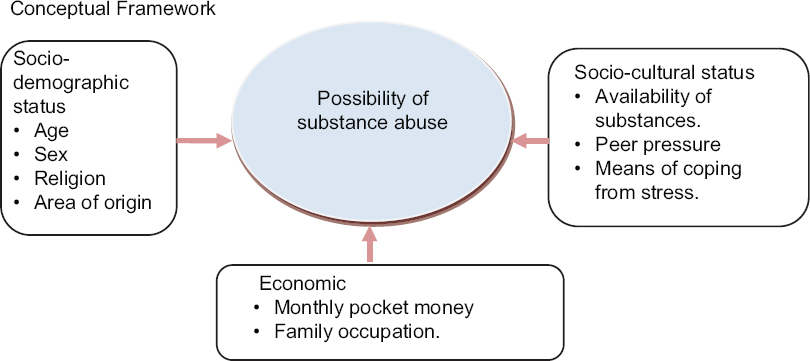
- Conceptual Frame work of factors associated with substance abuse. Source: Gezahegn T. et al., 2014
Materials and Methods
Study area and period
The study was conducted from May to June 2015 in Sheba University College (SUC) which is located in the northern part of Ethiopia 787 km far away from the capital city of Ethiopia. It is one of the oldest private University colleges in the country. During the study, the University has four faculties which are Health science, business and economics, informatics, and engineering. There are five departments under health science, namely, pharmacy, public health, nursing, midwifery, and clinical laboratory which are the study carried on.
Study design
An institution-based cross-sectional study was used.
Source population
All regular undergraduate health science students at SUC were the source population for the study.
Study population
All students who were randomly selected by simple random sampling technique from the SUC were source of population. Those regular undergraduate students, who are not blind and not critically sick (to the extent of being unable to read and write) during the time of data collection, were included.
Sample Size determination
The sample size (n = 1076) was primarily determined for the study of prevalence and factors associated with SA and attempt among SUC students. It was determined by taking the prevalence of SA among Mekelle university students 29.5%, 95% confidence level, marginal error of 5%, and 10% nonresponse rate. Using single population proportion formula, the sample size becomes 271.
Sampling procedure
The simple random sampling technique was used to select the study participants. There are 4 faculties in the SUC. Our main target study was health science faculty. Then, from health sciences departments, we took all four departments; namely the pharmacy, public health, midwifery, and nursing departments. Then, total of 271 samples was proportionally allocated over four departments. Finally, proportionally allocated sample was selected using simple random sampling method from each department. Students from each year of study were allocated proportionally to their class size [Figure 2].
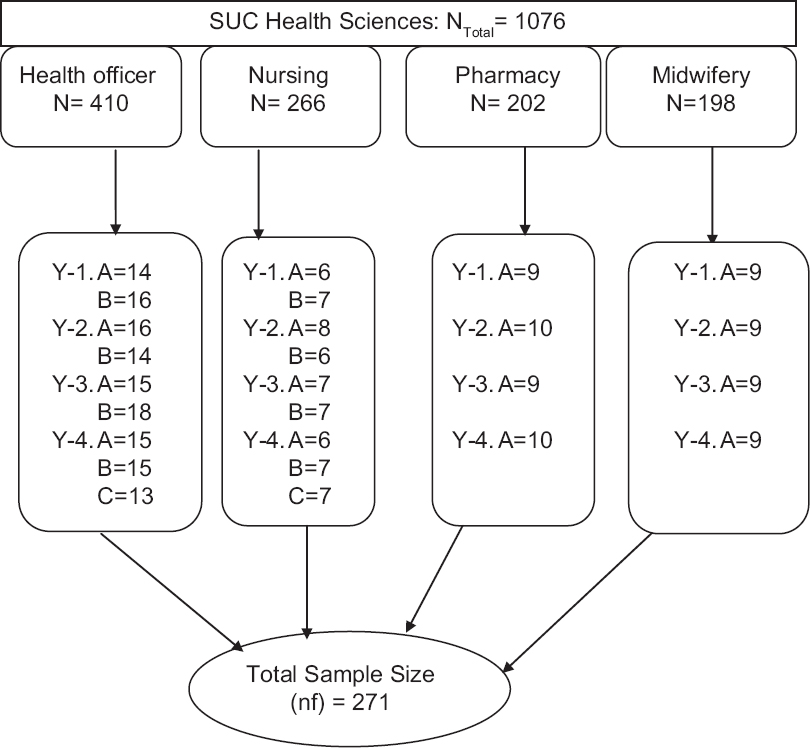
- Schematic presentation of sample size determination
Data collection procedure and tools
A structured questionnaire was used to collect data from the selected study population. The questionnaire was written in English, but translated into the local languages (Amharic and Tigryna) during the data collection. It was pilot tested in some departments which are not selected for this study. Through this pretest clarity of the questions in the questionnaire was checked. The principal investigator and data collectors were undertaken this pretest. Based on the feedback and findings of the pretest, necessary corrections and amendment on the questionnaire were done before the start of the actual data collection. The data collectors were second degree (master's) holders who have guided the students to complete the questionnaire. The data collectors explain each question to the students to help them understand the questions well and fill their own response to questionnaire. The principal investigators have followed and controlled overall data collection process.
Study variables
Independent variables
Sociodemographic characteristics (age, sex, religion, marital status, and monthly pocket money), year of study, depression status, and type of high school attended.
Dependent variable
The dependent variable is SA.
Data analysis
Subjects were assigned numbers as information is collected. Data cleaning was performed to check for accuracy, and consistencies and missed values and variables. Any logical and consistency error identified during data entry was corrected after revision of the original completed questionnaire. Descriptive statistics were done to describe the study population. Bivariate and multivariate analysis were employed to identify factors associated with the outcome variable. Odds ratio with 95% confidence interval was computed to assess the level of association and statistical significance.
Data quality control
The questionnaire it was pilot tested in some departments which are not selected for this study. The data collectors were second degree (master's) holders who have guided the students to complete the questionnaire. The collected data were reviewed and checked for completeness before data entry. Necessary corrections were made on the spot. Cleaning, coding, and entering of the data were carried out carefully.
Operational definitions
SA: Referred to as the use of at least one of the substances (alcohol, khat, cigarettes, and illicit drugs) in an individual's lifetime to alter mood or behaviour.
Current user: Use of substance at least once in the past month.
Ever use: Use of any of the substances at least once in a lifetime.
Illicit drugs: The use of psychoactive substances such as hashish, cannabis, and heroin, for which the production, sale, or use is prohibited.
Ethical statement
Ethical approval was obtained from Institutional Research Ethics Review Committee of SUC. Participation was voluntary, and the students were told that they can withdraw from the study at any time without explanation and penalty or loss of benefit. Confidentiality was assured, and no personal details were recorded or produced on any documentation related to the study. Written informed consent was obtained from all participants.
Results
Sociodemographic characteristics
Of the total 271 students participated in the survey, questionnaires from 271 respondents were considered for analysis making the response rate 100%. Most of the respondents were youths and their age ranges from 18 to 30 years with a mean age of 21 and standard deviation of ±1.68 years. Of the total participants, 165 (60.88%) were females. The previous residence for the majority of respondents, 186 (68.7%) were from urban setting and majority 253 (93.7%) were Tigre in their ethnicity. About 40% (110) of the students gets a monthly pocket money of <1000 ethiopian birr [Table 1]. The majority (84%) of the students were the age of 19–24 years. Likewise, about 89% of students were orthodox followers. Of study participant's family occupation, about 32.1% were a government employee followed by 31.2% merchants.
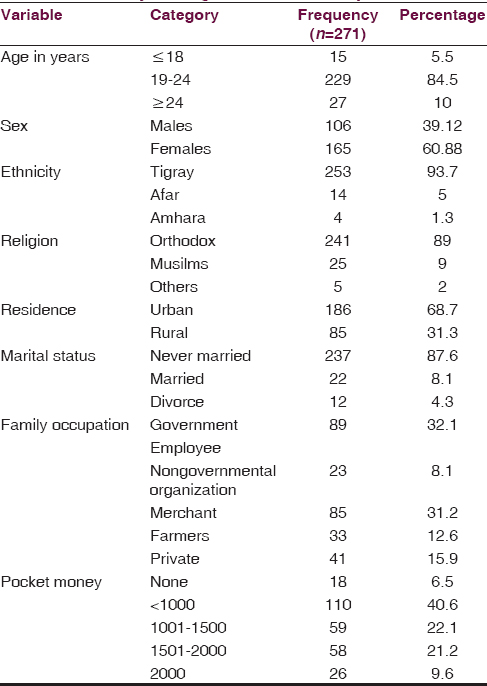
Substance use behavior
Of the 271 study participants, around 46% (124) were found to be substance abusers. The study revealed that 9.2% of the students chewed khat at least once in their lifetime, and 4% reported that they were currently chewing khat (from the last 3 months). The frequency among males (39.7%) was higher compared to females (16.0%). The respondents were further asked their chewing pattern. The response indicated that about (4.5%) chew khat occasionally (2–3 times/week), and 6.2% of respondents claimed chewing khat always (every day). Concerning alcohol drinking habits, 25% reported that they drank alcohol at least once in their lifetime while 12% said that they drank alcohol in the last 3 months. Among alcohol users, the majority (81.5%) were using alcoholic drinks occasionally [Table 2].
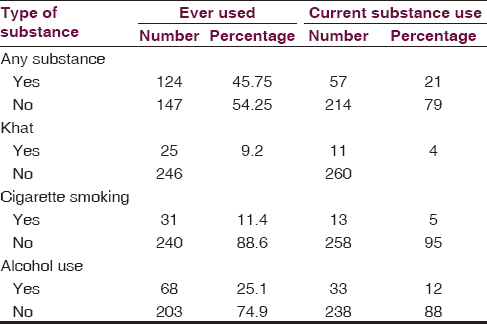
The time in which students started to use abused substances
Concerning the initiation time of substance use, 26% of participants started to use abused substances when they were elementary school students. 45.60% of the respondents started during secondary school life. 15.40% and nearly 11% of the respondents had started when they were at in preparatory school and college life, respectively [Figure 3].
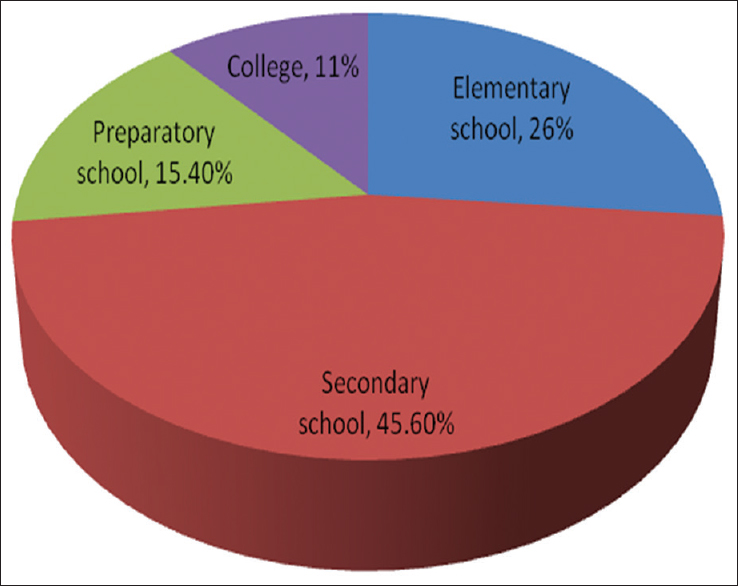
- Time of initiation to use abused substances among Sheba University College Students in mekelle town, Tigray, Ethiopia
Reason to use the substance
Various reasons were reported by students for in the use of drugs. The reasons for khat ever use were to increase work performance (27.5%), to get personal pleasure (20.5%), to stay awake (17.5%), due to peer pressure (8.9%), to get relief from tension (7.5%), and other reasons (18.1%). Among 31 students who reported taking alcohol, 21 (66.9%) used alcohol to get personal pleasure, 6 (18.5%) to get relief from tension and 5 (16.9%) took it due to peer influence. Reasons for cigarette smoking among the 68 participants were to get personal pleasure 29 (42%), to get relief from tension 19 (29.0%), to stay awake 3 (3.5%), to increase academic performance 9 (13.5%), and peer influence 8 (12.0%).
Discussion
Our study showed that the prevalence of substance use for at least one substance was 45.5%. The most frequently used drugs were cigarette (11.4%), khat (9.2%), and alcohol (25.1%). A similar study in many African universities which was 69.8%.[1718] The prevalence rate of lifetime cigarette use in this study was 11.4%, which is similar with the study conducted among college students in North Western Ethiopia 13.1%,[22] a study done among Mekelle University students, 17.5%,[25] and Secondary School of Nigeria 14.3%,[30] report from Chinese University, 13%. our finding is higher than findings obtained from Western Kenya, 2%. The discrepancy could be due to the population's prevailing social, cultural variations, and study time difference in the respective countries.
Our study showed that 9.2% of the participants were ever khat chewers. A similar study was done in Addis Ababa, 35.6%, the study conducted among college students in North Western Ethiopia 26.7%[22] and in high school students in South-Western Ethiopia, 64.9%.[18] Current khat chewers in this study were 4% of the study subjects. This is lower than a report from the Jazan region of Saudi Arabia in which the prevalence of khat use among high school students was 21.4%,[30] the study conducted among college students of North West Ethiopia 17.5%,[22] the study done among Haramaya University students 20.3%,[24] the study among Jimma University staffs which was 30.8%.[21] The observed differences in khat chewing could be due to differences in sample characteristics, cultural differences in understanding of the amount of chewing and methodological differences.
In addition, the proportions of ever alcohol drinkers in this study were 25.1%. The finding of this study is lower than the study among the students of Mekelle university; 69.7%,[25] findings reported from students of Ambrose Alli University; Ekpoma, Nigeria represents 66% and in line with 61% among Chinese, University Students in Hong Kong. The difference in educational programs between countries could be contributing factors to this variable rate of alcohol consumption. In general, the differences indicated might be due to the population difference under study, and promotion of publicity. The difference in educational programs between countries and the time the research was undertaken could also be contributing factors for this variable rate of substance use and abuse. Organizational, physical and behavioral property variables of campuses, including the type of residence, institutional size, location, and campus community property variables could also be reasons to the variations.
Conclusion
The present study showed a lower magnitude (45.6% ever use and 21% still using) of SA among students' compared to other studies. Our study also assessed the reason for substance use and to increase a work performance was the leading reason followed by personal pleasure. Although our finding showed the low proportion of SA comparing to other finding it is still a considerable problem in the study area. As our study focuses on undergraduate medical students, the findings would be helpful to initiate effective substance use control programs in health science schools and would also serve as a stimulator to conduct further studies on this topic in Ethiopia.
Financial support and sponsorship
Nil.
Conflicts of interest
There are no conflicts of interest.
Acknowledgments
The authors acknowledge the immense help received from the scholars whose articles are cited and included in references of this manuscript. The authors are also grateful to authors/editors/publishers of all those articles, journals, and books from where the literature for this article has been reviewed and discussed.
References
- Prevalence and causes of substance abuse among undergraduate medical students. Indian Med Gaz 2014:276-82.
- [Google Scholar]
- Prevalence of substance abuse among the medical students in Southern Iran. Shiraz E Med J. 2010;11:198-202.
- [Google Scholar]
- Substance use among secondary school students in an urban setting in Nigeria: Prevalence and associated factors. Afr J Psychiatry (Johannesbg). 2010;13:52-7.
- [Google Scholar]
- Substance use and associated factors among university students in Ethiopia: A cross-sectional study. J Addict. 2014;2014:969837.
- [Google Scholar]
- Substance abuse prevalence and its relation to scholastic achievement and sport factors: An analysis among adolescents of the Herzegovina-Neretva Canton in Bosnia and Herzegovina. BMC Public Health. 2012;12:274.
- [Google Scholar]
- Ethnicity, substance use, and development: Exemplars for exploring group differences and similarities. Dev Psychopathol. 1999;11:805-22.
- [Google Scholar]
- Convention on Psychotropic Substances: Conference for the Adoption of a Protocol on Psychotropic Substances. Vienna, United Nations.
- Assessment of Substance Use and Risky Sexual Behaviour among Haramaya University Students, Ethiopia. Sci J Public Health. 2014;2:102-10.
- [Google Scholar]
- Effect of substance use on academic achievement of health officer and medical students of Jimma University, Southwest Ethiopia. Ethiop J Health Sci. 2009;19:155-63.
- [Google Scholar]
- AIDS Epidemic Update, December 2001. Geneva, Switzerland: UNAIDS/WHO; 2001.
- Early-onset drug use and risk of later drug problems. Drug Alcohol Depend. 1995;40:9-15.
- [Google Scholar]
- Development of a racial and ethnic identity scale for African American adolescents Black. J Black Psychol. 1999;25:2:171-88.
- [Google Scholar]
- Prevalence of substance abuse among senior secondary students In Mainland Local Government, Lagos. Glob J Med Public Health. 2014;3:2277-9604.
- [Google Scholar]
- Pattern of substance abuse among senior secondary school students in a Southwestern Nigerian city. Int Rev Soc Sci Humanit. 2013;4:54-65.
- [Google Scholar]
- Assessment on the prevalence and contributing factors of social drugs utilization among university of Gondar regular undergraduate students. Int J Pharma Sci Res. 2014;5:518-30.
- [Google Scholar]
- Substance abuse in the Western Cape Province of South Africa: Insights through mathematical modeling. The quarterly update on epidemiology from the South African Centre for Epidemiological Modelling and Analysis 2010
- [Google Scholar]
- Psychopathology as a predictor of adolescent drug use trajectories. Psychol Addict Behav. 2001;15:210-8.
- [Google Scholar]
- Drug use prevention among young people: A review of reviews evidence briefing update (NHS) National Institute for Health and Clinical Excellence 2006
- [Google Scholar]
- Statistics South Africa. In: The Youth of South Africa. Pretoria, South Africa: Statistics South Africa; 2001.
- [Google Scholar]
- Cigarette smoking and khat chewing among university instructors in Ethiopia. East Afr Med J. 2002;79:274-8.
- [Google Scholar]
- Neighborhood influences and child development: A prospective study of substance abusers' offspring. Dev Psychopathol. 1999;11:763-84.
- [Google Scholar]
- The association between substance abuse and HIV infection among people visiting HIV counseling and testing centers in Addis Ababa, Ethiopia. Ethiop J Health Development. 2005;19:116-25.
- [Google Scholar]
- Module in for ethino -suharan substance abuse H.center team 2005:12-4.
- Risk and protective factors of adolescent drug use: Implications for prevention programs. Handbook of Drug Abuse Prevention 2006:265-87.
- [Google Scholar]
- Explaining Delinquency and Drug Use. Beverly Hills, CA: Sage; 1985.
- The association between substance abuse and HIV infection among people visiting HIV counseling and testing centers in Addis Ababa, Ethiopia. Ethiop J Health Dev. 2005;19:116-25.
- [Google Scholar]
- Drug use etiology among ethnic minority adolescents (Risk and protective factors) In: Botvin GJ, Shenki S, Orlandi MA, eds. Drug Abuse Prevention and Multi-Ethnic Youth. Thousand Oaks, CA: Sage; 1995. p. :105-29.
- [Google Scholar]
- Substance use and its predictors among undergraduate medical students of Addis Ababa University in Ethiopia. BMC Public Health. 2011;11:660.
- [Google Scholar]
- Substance use and sexual risk behavior and factors associated with HIV transmission in Southern Ethiopia. Int J Pharma Sci Res. 2012;3:1080-6.
- [Google Scholar]
- Prevalence of khat chewing in college and secondary (high) school students of Jazan region, Saudi Arabia. Harm Reduct J. 2009;6:11. doi:10.1186/1477-7517-6-11
- [Google Scholar]






